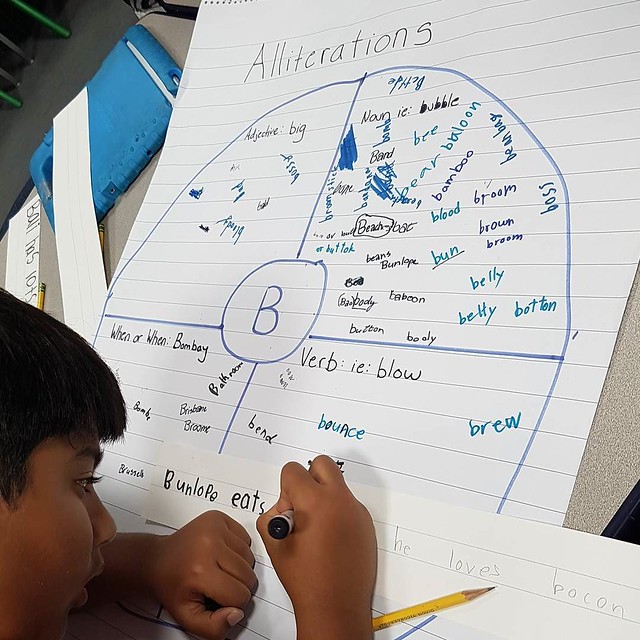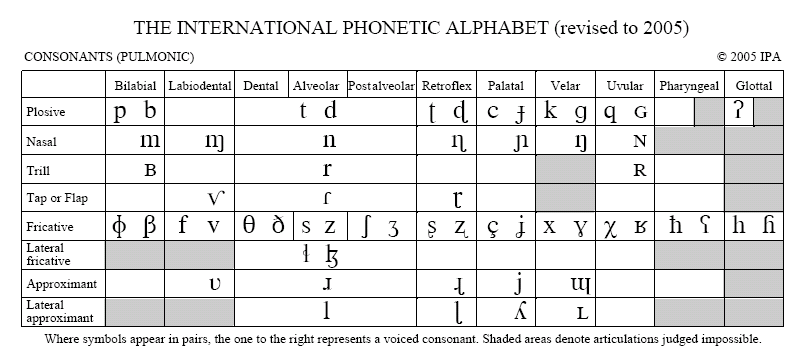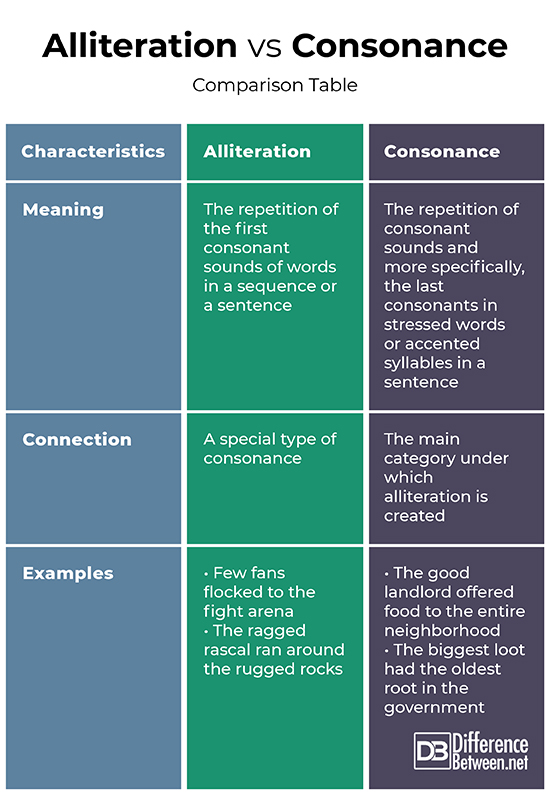Difference Between Alliteration and Consonance
Alliteration and consonance are literary devices used for emphasizing some phrases and words in a workpiece. They are also used to engage the workpiece reader’s auditory senses. Even though the two are almost similar since they deal with the repetition of consonants, they are varied in their meanings, applications, and position in a sentence.
So, what is the difference between alliteration and consonance? Can each stand for the other or can the two be interchanged with each other? Those are the questions most people would ask and can only be answered by diving deeper into the study of both words and differentiating them.

What is Alliteration?
Alliteration can be defined as a special case of consonance where there are repeated consonant sounds at a stressed syllable. It is distinguished from consonance, however, because the consonants, in this case, are repeated at the beginning of two or more words in a sentence.
Noticeably, alliteration is used in poetry and prose for adding catchy sounds. It is also sometimes used to represent actions along with audible effects.
Examples of Alliteration
- After the wicked woman from the west was arrested, wished she wasn’t a witch.
- She stood stalk still seriously wounded.
- The friendly farmer fed the five families every year.
- Better batter makes batter better.

What is Consonance?
Consonance is also a stylistic literary device that applies the repetition of similar or identical consonants at the end of a couple or more words in a sentence. The vowels of those words, however, are different.
Examples of Consonance
- The big ugly frog leaped on a log.
- Lady luck struck again.
- All that starts well ends well.
Difference Between Alliteration and Consonance
Despite them both being literary devices that apply the repetition of consonants, alliteration and consonance have their differences, that is:
-
Meaning of Alliteration Vs. Consonance
Alliteration is a stylistic device where consonant sounds are repeated at a stressed part of the word, usually at the beginning. Consonance, on the other hand, is similar to alliteration in that it employs the repetition of consonants. However, in consonance, the repetition happens at the end of closely connected, following, or adjacent words in a sentence.
-
Consonant Sound in Alliteration Vs. In Consonance
In alliteration, the consonant sound appears at the beginning of a word or the stressed part of it. Conversely, the consonant sound in consonance is repeated with emphasis on the end of the stressed words.
-
Connection Between Alliteration and Consonance
Alliteration is a part of consonance while consonance is the main category which alliteration falls under.
-
Examples of Alliteration Vs. Consonance
Examples of alliteration:
- A good man is gruff, grumpy, and cranky.
- The witch’s wishes made the woman worried.
- The seashore shells she bought are on sale again.
Examples of consonance
- The first and last brush sweeps fast and best.
- He said he would come home hot and on foot.
Alliteration Vs. Consonance: Comparison Table

Summary of Alliteration Vs. Consonance
Alliteration and consonance are applied in the worlds of literature, poetry, and prose to add rhythm, to pieces of work, engage a reader’s auditory skills, and make the piece interesting. They both involve the repetition of consonants, but they have a striking difference. With the major one being that one focuses on the repetition of initial consonants while the other focuses on the repetition of mostly the last ones, the two are no doubt dissimilar.
- Difference Between Minecraft and Terraria - August 7, 2020
- Difference Between Alliteration and Onomatopoeia Poems - July 25, 2019
- Difference Between Certification and Licensure - July 24, 2019
Search DifferenceBetween.net :
7 Comments
Leave a Response
References :
[0]Image credit: https://upload.wikimedia.org/wikipedia/commons/8/82/IPA_Pulmonic.gif
[1]Image credit: https://www.flickr.com/photos/jasongraham99/26537885615
[2]Literary Devices. (2019). Alliteration - Examples and Definition of Alliteration. [online] Available at: http://literarydevices.net/alliteration/ [Accessed 1 May 2019].
[3]Ojumu, B. (2019). Difference between ALLITERATION, ASSONANCE and CONSONANCE | Passnownow. [online] Passnownow.com. Available at: https://passnownow.com/grammar-clinic-the-real-difference-between-alliteration-assonance-and-consonance/ [Accessed 1 May 2019].

It’s in fact very dirficult in this busy life to listenn ews
on TV, so I simply use web for that purpose, and
get the latest news.
Pretty portion of content. I simply stumbled upon your site and in accession capial to claim that I gget actually loved account your blog posts.
Any way I’ll be subscribing in your feeds or evgen I fulfillment you gget admission to
constantly rapidly.
Can I just say what a relief to discover somebody that really knows what they’re discussing online.
You certainly understand how tto bring a problem to light and make it important.
A lot more people ought to look at this and understand this side of your story.
It’s surprising you’re not more popular since you definitely have the gift.
Hello to every one, the contents present at this web
page are actually awesome for people knowledge, well, keep up the nice
work fellows.
If you would like to get a great deal from this paragraph then you have to apply such
strategies to your won website.
Right here is the perfect website foor anyone who hopes
to find out about this topic. You know a whole lot its almost tough to argue with you (not that
I personally will need to…HaHa). You definitely
put a new spin on a subject that has been written about for decades.
Great stuff, just wonderful!
This was not very helpful but thanks for trying?